Research Highlights 2012
Anomalous Behaviour of the Diffusion Coefficient in Thin Active Films
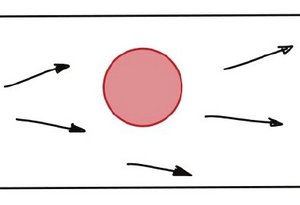
We study the diffusion of a smaller tracer particle in a fluctuating active gel. In a passive fluid, the diffusion coefficient depends on the particle radius as well as on the fluid viscosity. Here we show that in an active fluid, the diffusion coefficient can exhibit unconventional properties and can depend on the system size rather than the particle size. Such anomalous behavior of the diffusion coefficient results from close to a Frederiks transition.
A. Basu, J.-F. Joanny, F. Jülicher and J. Prost
New J. Phys. 14, 115001 (2012)
[PDF (565 kB)]
Positioning of Microtubule Organizing Centers by Cortical Pushing and Pulling Forces
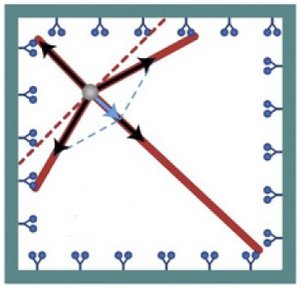
During cell division, the mitotoc spindle is positioned in the cell near the cell center. Interactions between microtubule ends with the cell boundaries are important for this positioning. Growing microtubules can push against the cell boundary while microtubules interacting with dynein molecular motors at the cell boundary can be subject to pulling. Here we show that pulling forces exerted by dynein motors can provide a robust and stable centering mechanism.
N. Pavin, L. Laan, R. Ma, M. Dogterom and F. Jülicher
New J. Phys. 14, 105025 (2012)
[PDF (1,5 MB)]
Cortical Dynein Controls Microtubule Dynamics to Generate Pulling Forces that Position Microtubule Asters
L. Laan, N. Pavin, J. Husson, G. Romet-Lemonne, M. van Duijn, M. Preciado López, R. D. Vale, F. Jülicher, S. L. Reck-Peterson and M. Dogterom
Cell 148, 502 (2012)
[PDF (1,9 MB)]
Active Chiral Fluids
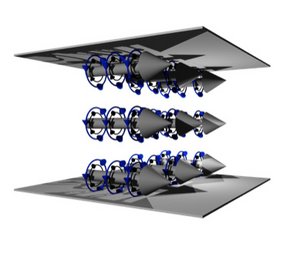
Motor molecules interacting with filaments of the cytoskeleton can induce relative sliding of two filaments. In addition, because of the helical structure of filaments, relative filament rotation can occur. Such active chiral processes can give rise to novel and unconventional material properties in active chiral gels. We present a general hydrodynamic theory of active fluids which takes into account chiral processes. We show that active antisymmetric stresses as well as active contributions to angular momentum fluxes occur and we discuss generic terms that arise due to the existence of torque dipoles in an active medium.
S. Fürthauer, M. Strempel, S. W. Grill and F. Jülicher
Eur. Phy. J. E 35, 89 (2012)
[PDF (1,5 MB)]
Flagellar Synchronization Independent of Hydrodynamic Interactions
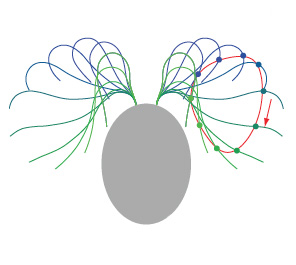
Inspired by the coordinated beating of the flagellar pair of the green algae Chlamydomonas, we study theoretically a simple, mirror-symmetric swimmer, which propels itself at low Reynolds number by a revolving motion of a pair of spheres. We show that perfect synchronization between these two driven spheres can occur due to the motion of the swimmer and local hydrodynamic friction forces. Hydrodynamic interactions, though crucial for net propulsion, contribute little to synchronization for this free-moving swimmer.
B. M. Friedrich and F. Jülicher
Phys. Rev. Lett. 109, 138102 (2012)
[PDF (446 kB)]
A General Theoretical Framework to Infer Endosomal Network Dynamics from Quantitative Image Analysis
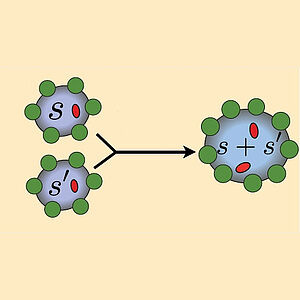
Cells internalize many different molecules including nutrients and signaling ligands. After internalization by endocytosis, these molecules are sorted and further processes in endosomal networks. We present a general theory to understand the emergent properties of the endosome network resulting from the interactions of individual endosomes. Using quantitative image analysis, we determine cargo-distributions in the network. We estimate key kinetic parameters of the network and show that endosome fusion plays a particularly important role for shaping endosomal networks leading to power-laws in the cargo distributions.
L. Foret, J. E. Dawson, R. Villasenor, C. Collinet, A. Deutsch, L. Brusch, M. Zerial, Y. Kalaidzidis and F. Jülicher
Curr. Biol. 22, 1381 (2012)
[PDF (1 MB)]
Establishment of Global Patterns of Planar Polarity during Growth of the Drosophila Wing Epithelium
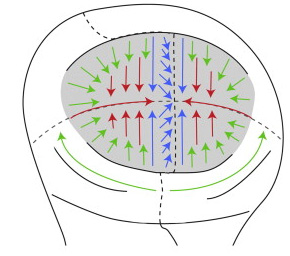
Many epithelia exhibit large scale polarity patterns in the plane of the tissue. An important model system is the wing of the fruit fly where this polarity is reflected in the aligned patterns of wing hairs. In order to study how this pattern emerges during development, we quantify patterns of planar cell polarity proteins in the wing imaginal disk which is the wing precursor in the larvae. We find that planar cell polarity patterns emerge at early stage and that they are guided by the activity of three organizer regions including two compartment boundaries.
A. Sagner, M. Merkel, B. Aigouy, J. Gaebel, M. Brankatschk, F. Jülicher and S. Eaton
Curr. Biol. 22, 1296 (2012)
[PDF (401 kB)]
Topology and Dynamics of the Zebrafish Segmentation Clock Core Circuit
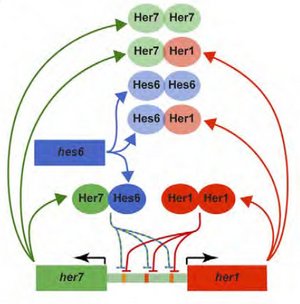
The verterate body has a segmented organization. During embryo development, these segments form sequentially by a dynamic process that involves genetic cellular oscillations in individual cells. Here we discuss the organization of the genetic work that governs these oscillations. We present a simplified dynamic model of gene regulation that involves two negative feedback loops of gene regulation. Transcription is regulated by different dimers of gene products. Our model can account for wild type behaviors and the effects of several mutants.
C. Schröter, S. Ares, L. G. Morelli, A. Isakova, K. Hens, D. Soroldoni, M. Gajewski, F. Jülicher, S. J. Maerkl, B. Deplancke and A. C. Oates
PloS Biol 10, e1001364 (2012)
[PDF (843 kB)]
A mean-field Approach to Elastically Coupled Hair Bundles
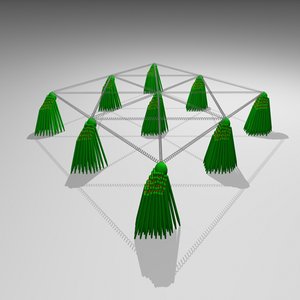
The sensory cells of the ear, called hair cells, are active elements that can amplify weak mechanical stimuli. This amplification is based on the properties of dynamic oscillators. Here we study the behaviors of noisy oscillating hair bundles that are mechanically coupled. Our analytical approach elucidates the origin of noise reduction and reveals the importance of a new collective degree of freedom for the collective behaviours.
K. Dierkes, F. Jülicher and B. Lindner
Eur. Phys. J. E 35, 37 (2012)
[PDF (1,1 MB)]
Tissue Dynamics with Permeation
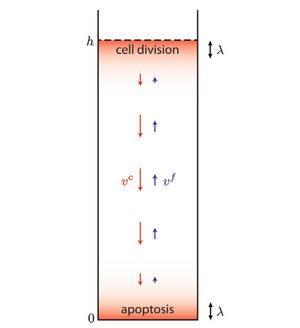
Animal tissues are complex assemblies of cells, extracellular matrix and permeating interstitial fluid. We develop a two-component continuum description of tissue dynamics taking into account a cell phase and an interstitial fluid. Cell growth requires absorption of the fluid while apoptosis releases interstitial fluid such that mass is conserved. Friction between the interstitial fluid and the cell phase leads to a Darcy-like relation for the fluid velocity and introduces a new characteristic length scale.
J. Ranft, J. Prost, F. Jülicher and J.-F. Joanny
Eur. Phys. J. E 35, 46 (2012)
[PDF (723 kB)]
Collective Modes of Coupled Phase Oscillators with Delayed Coupling
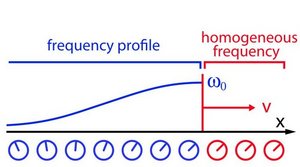
We derive a general continuum theory that describes long wavelength modes of coupled oscillator with time delays in the coupling. We use our approach to investigate phase profiles of genetic oscillators in the segmentation clock which generates the segmented pattern of the vertebrate body plan. In this system, genetic oscillations together wit a moving front gives rise to wave like-collective modes. We discuss the influence of time delays on the phase profile of oscillators.
S. Ares, L. G. Morelli, D. J. Jörg, A. C. Oates and F. Jülicher
Phys. Rev. Lett. 108, 204101 (2012)
[PDF (229 kB)]
Physical Mechanisms Shaping the Drosophila Dorsoventral Compartment Boundary
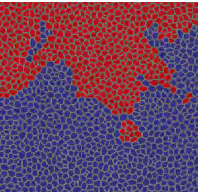
In many tissues, cells are organized in distinct compartments separated by sharp boundaries. We study physical mechanisms that contribute to the morphology of compartment boundaries in the developing wing of the fly. In addition to increased cell bond tension at the boundary we show that a bias of cell division by cell elongation has a significant effect to reduce interface roughness.
M. Aliee, J.-C. Röper, K. P. Landsberg, C. Pentzold, T. J. Widmann, F. Jülicher and C. Dahmann
Curr. Biol. 22, 1 (2012)
[PDF (1,6 MB)]
The Taylor–Couette Motor: Spontaneous Flows of Active Polar Fluids Between two Coaxial Cylinders
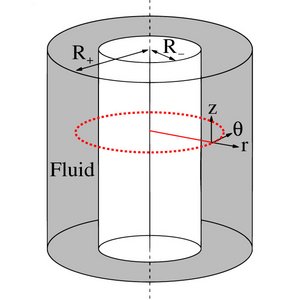
We discuss the behaviors of a polar or nematic active fluid confined between concentric cylinders and show that this system can behave as a rotatory motor. In the absence of an external torque, the fluid can generate a flow field with broken chiral symmetry which then results in the cylinders rotating relative to each other at a particular rate. If an external torque is applied the rotation rate changes and the system performs mechanical work. The relationship between rotation rate and the applied torque characterizes the mechanical properties of this motor.
S. Fürthauer, M. Neef, S. W. Grill, K. Kruse and F. Jülicher
New. J. Phys. 14, 023001 (2012)
[PDF (655 kB)]